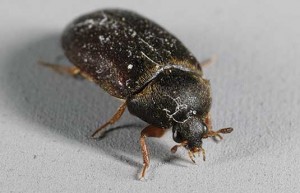
A black carpet beetle adult. Its larvae will consume just about any unprotected dry organic material. They are also common on outdoor blossoms. Photo: K.S. Matz
Q: Recently, an older apartment building had new windows installed. One of the tenants has complained about black carpet beetles coming from the window. She says she sees them flying up and down the hall. I can deal with the carpet beetles, but why did replacing the windows cause the problem? — Richard H., New York
A: Black carpet beetles (Attagenus unicolor) are general scavengers, and feed mostly on lint accumulations behind baseboards. You said this was an older apartment building — that’s the kind of structure that can harbor black carpet beetles. New buildings haven’t accumulated organic matter in hidden cracks and crevices yet.
I suspect this building has had black carpet beetles for many years, but no one noticed. When the windows were replaced, harborages were disturbed—and the beetles moved to seek new ones. I doubt the adults are flying up and down the hall, but you’ll never convince the apartment tenant of that.
Q: I have the opportunity to provide pest management services for owners of a horse barn, which has more than 50 stalls and houses horses valued at six figures. Obviously, I don’t want to harm the horses. The pest problems include rats, house flies and American cockroaches. I’m not sure what to use to get control while keeping the horses safe. — Barry B., New Jersey
A: Sometimes you need to walk away from jobs that prove to be too much of a challenge. However, there are a few things you might consider if you want to offer a proposal:
-
- Sanitation is important, but that might not be practical in this case.
- If the barn is on a concrete slab, you can establish a good rodent control program with exterior baits in appropriate bait stations. If the barn has dirt floors and rodents are burrowing in the dirt, consider dusting the burrows with tracking powder and closing the borrows after.
- American cockroaches (Periplaneta americana) can be controlled with baits, but they’ll need to compete with existing food sources. Use baits in manufacturers’ stations to prevent horses from reaching them. An insect growth regulator (IGR) will help provide long-term control.
- Flies can be controlled with scatter baits. House flies (Musca domestica) also like to rest on ceilings in barns. If this is true in your case, spray the ceilings with a good residual when the horses are out of the barn. Again, an IGR will help provide long-term control of the flies.
- While they take time to provide control, IGRs alone will reduce populations. If you choose not to use any baits, an IGR program will help. They’re also considered harmless to horses. If you choose this route, though, your client must understand there will still be flies and cockroaches present.
Q: What can I do about maggots? They are being found in a room near a fireplace. I can’t find maggots listed on any insecticide labels. — Frank D., New York
A: Maggots (fly larvae) are difficult to kill. Control consists of removing the source. Pesticides are seldom necessary.
In your case, I’m guessing there’s a dead animal in the chimney; the maggots are dropping down into the fireplace. They will pupate in cracks and crevices. In a few days, flies will appear on the inside of the windows. A residual on the windowsills will knock down the adults until the cycle ends.
Email your questions about insect identification and pest management technologies and techniques to Dr. Doug Mampe, an industry consultant, at dentomol@aol.com. Your questions most likely will be printed and answered in one of Pest Management Professional’s upcoming Ask the Expert columns.
Leave A Comment